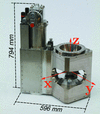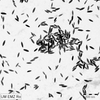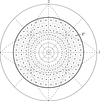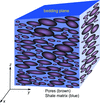issue contents
February 2018 issue

Cover illustration: TOPAS and its academic variant TOPAS-Academic are nonlinear least-squares optimization computer programs written primarily for the analysis of crystallographic problems. In this issue, Alan Coelho [J. Appl. Cryst. (2018), 51, 210-218] describes their functionality and architecture.
research papers
The concept, design and performance of the variable-wavelength Bonse–Hart ultra-small-angle neutron scattering diffractometer KOOKABURRA at ANSTO are described.
The design of a polarized neutron reflectometry sample environment capable of simultaneously measuring the ferromagnetic resonance response of a magnetic thin film is presented.
A setup for polarized neutron diffraction with short-wavelength neutrons using a high-temperature superconducting magnet in combination with 3He spin filters has been developed on the new single-crystal diffractometer POLI at MLZ, Germany. A polarized neutron spin transport efficiency of about 99% has been proven and the first experiments successfully performed.
The structure of a natural CT opal from Ethiopia is explored with a new method, using Fourier transformation, applied to scanning electron microscope images.
This work describes an inverse transform approach for analysis of X-ray photon correlation spectroscopy (XPCS) data that reveals dynamic heterogeneity.
Python-based applications streamline stock and sample management in a medium-throughput crystallization laboratory and yield information as to what chemicals are used in crystallization trial optimization.
An electron backscatter diffraction (EBSD)-assisted X-ray Laue microdiffraction (µLaue) method has been developed to determine local strain in materials with complex microstructures. The method uses EBSD data on crystal orientation as starting information for a µLaue pattern indexing procedure with template matching. The final determination of strain from the analysis of a µLaue pattern composed of a large number of intricate and closely located peaks becomes possible in an automatic way.
This paper presents a comparison of grating-based holography using X-rays and neutrons and tests the validity of analysis methods based on a weak phase approximation.
A computationally efficient tool, based on the natural hierarchical structure present in composite materials containing crystalline and amorphous domains, is demonstrated to rapidly extract structural information without the need of high-performance computing resources.
Nematic order parameters and orientational distribution functions of anisotropic magnetic hematite particles suspended in water and embedded in different poly(N-isopropylacrylamide) hydrogels are determined by means of small-angle X-ray scattering. Owing to particle–matrix interactions, the field-induced nematic alignment of the particles is progressively hindered by the increasing elasticity of the polymer network.
Size exclusion chromatography (SEC) small-angle X-ray scattering (SAXS) is a powerful structural biology tool where the best outcomes are obtained through an optimized experimental approach. Optimization of SEC and integration of a sheath flow sample environment into the Australian Synchrotron's SAXS/WAXS beamline has greatly improved data quality and the ability to deal with difficult protein samples.
A new deconvolution method based on least squares and penalty functions has been developed; critical to its success is a conjugate gradient solution routine for solving the matrix equation Ax = b.
A methodology providing a novel way of obtaining texture information from atomic configurations is presented. The effect of texture on deducing grain size from simulated X-ray diffraction curves and the texture evolution of nanocrystalline Ta under shock compression are also explored as application cases of texture analysis.
Open  access
access
 access
accessA new particle-injection approach is demonstrated that achieves very low background in the measurement of diffraction from macromolecular nanocrystals by using an aerosol-focusing injector with an X-ray free-electron laser.
Methods for correct interpretation of the Laue patterns of quartz are provided so that confusable Bragg reflections with the same Bragg angle but with different reflectivity and bandpass are clearly distinguished. This is important for the design and fabrication of quartz-based X-ray analyzers and polarizers.
A novel procedure for obtaining the overall elastic strain in a textured polycrystalline material from diffraction-based data is described. The resulting tensor is shown to be the best approximation of the average strain.
Open  access
access
 access
accessSolution scattering data from lipid nanodiscs are interpreted on the basis of X-ray scattering data in an extended range of scattering vectors.
Open  access
access
 access
accessThe article presents a theoretical study on dynamic artefacts in the reconstruction of Bragg coherent diffractive imaging using an iterative phase retrieval algorithm.
Anisotropic systems measured at small angles require a two-dimensional detector to observe the elliptical contours. This gives information necessary for the analysis of measurements for which the range is extended to ultra-small angles using the double-crystal technique.
An investigation into the source of unusual features in the powder X-ray diffraction pattern of a slow-cooled reduced ilmenite is presented. Using transmission electron microscopy, selected area electron diffraction and pair distribution function analysis, these features were established to be due to the presence of an M3O5–anatase intergrowth phase that did not form when the sample was rapidly cooled.
computer programs
A C++ library for calculation of structure factors from the Hansen–Coppens multipolar model of crystal electron density, featuring parallel implementation for multi-core processors and graphics processing units, is presented.
Open  access
access
 access
accessA new standalone program to calculate optimized values for weighting parameters, CAPOW, is presented along with enhanced visualization tools for analysing statistical distributions of data.
This work describes the software package CONTIN XPCS for inverse transform analysis of X-ray photon correlation spectroscopy data.
TOPAS is nonlinear least-squares optimization computer program written primarily for the analysis of crystallographic problems.
The program CarbX for the analysis of non-graphitic carbons is presented.
addenda and errata
Open  access
access
 access
accessbook reviews
Free 



 journal menu
journal menu














































